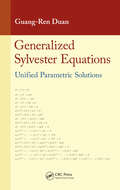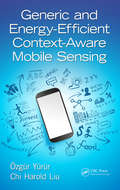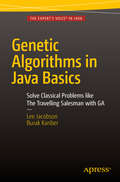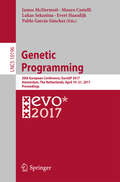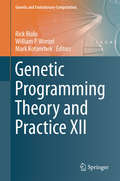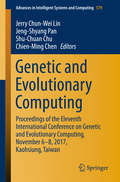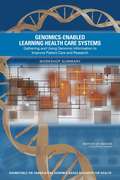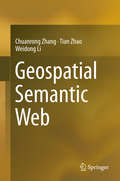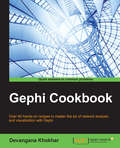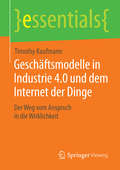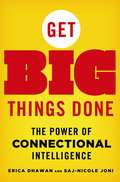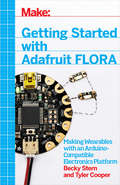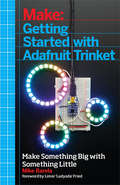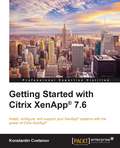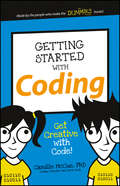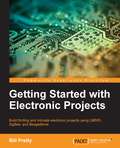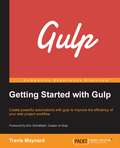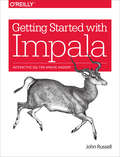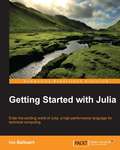- Table View
- List View
Gender, Age, and Digital Games in the Domestic Context (Routledge Advances in Game Studies)
by Alison HarveyWestern digital game play has shifted in important ways over the last decade, with a plethora of personal devices affording a range of increasingly diverse play experiences. Despite the celebration of a more inclusive environment of digital game play, very little grounded research has been devoted to the examination of familial play and the domestication of digital games, as opposed to evolving public and educational contexts. This book is the first study to provide a situated investigation of the site of family play— the shared spaces and private places of gameplay within the domestic sphere. It carries out an empirically grounded and critical analysis of what marketing and sales discourses about shifts in the digital games audience actually look like in the space of the home, as well as the social and cultural role these ludic technologies take in the everyday practices of the family in the domestic context. It examines the material realities of video game technologies in the home; including time management and spatial organization, as well as the discursive role these devices play in discussions of technological competence and its complex relationship to age, generational differences, and gender performance. Harvey’s interdisciplinary approach and innovative methodology will hold great critical appeal for those studying digital culture, children’s media, and feminist studies of new media, as well as critical theories of technology and leisure and sport theory.
Generalized Sylvester Equations: Unified Parametric Solutions
by Guang-Ren DuanProvides One Unified Formula That Gives Solutions to Several Types of GSEsGeneralized Sylvester equations (GSEs) are applied in many fields, including applied mathematics, systems and control, and signal processing. Generalized Sylvester Equations: Unified Parametric Solutions presents a unified parametric approach for solving various types of GSEs
Generic and Energy-Efficient Context-Aware Mobile Sensing
by Chi Harold Liu Ozgur YururElaborating on the concept of context awareness, this book presents up-to-date research and novel framework designs for context-aware mobile sensing. Generic and Energy-Efficient Context-Aware Mobile Sensing proposes novel context-inferring algorithms and generic framework designs that can help readers enhance existing tradeoffs in mobile sensing,
Genetic Algorithms in Java Basics
by Lee Jacobson Burak KanberGenetic Algorithms in Java Basics is a brief introduction to solving problems using genetic algorithms, with working projects and solutions written in the Java programming language. This brief book will guide you step-by-step through various implementations of genetic algorithms and some of their common applications, with the aim to give you a practical understanding allowing you to solve your own unique, individual problems. After reading this book you will be comfortable with the language specific issues and concepts involved with genetic algorithms and you'll have everything you need to start building your own. Genetic algorithms are frequently used to solve highly complex real world problems and with this book you too can harness their problem solving capabilities. Understanding how to utilize and implement genetic algorithms is an essential tool in any respected software developers toolkit. So step into this intriguing topic and learn how you too can improve your software with genetic algorithms, and see real Java code at work which you can develop further for your own projects and research. Guides you through the theory behind genetic algorithms Explains how genetic algorithms can be used for software developers trying to solve a range of problems Provides a step-by-step guide to implementing genetic algorithms in Java What you'll learn How to construct genetic algorithms in Java which you can extend for your own projects and research What genetic algorithms are and the biological inspiration behind them How genetic algorithms can be implemented to solve problems Solving a traveling salesman problem and how to apply a genetic algorithm to it How to use a genetic algorithm to solve timetabling problems How a genetic algorithm can be used to build a robotic controller Applying optimization techniques to genetic algorithms Who this book is for Genetic Algorithms in Java Basics is perfect for developers, researchers and students who are working on problems where genetic algorithms may be a solution and need to program real, working code in Java. It's also suitable for all Java developers who are curious about genetic algorithms who would like a practical, hands-on introduction to genetic algorithms using Java. Table of Contents 1. Introduction 2. Implementation of a Basic Algorithm 3. Robot Controllers 4. Traveling 5. Class Scheduling 6. Optimization
Genetic Programming
by James Mcdermott Mauro Castelli Pablo García-Sánchez Lukas Sekanina Evert HaasdijkThis book constitutes the refereed proceedings of the 18th European Conference on Genetic Programming, EuroGP 2015, held in Copenhagen, Spain, in April 2015 co-located with the Evo 2015 events, EvoCOP, Evo MUSART and Evo Applications. The 12 revised full papers presented together with 6 poster papers were carefully reviewed and selected form 36 submissions. The wide range of topics in this volume reflects the current state of research in the field. Thus, we see topics as diverse as semantic methods, recursive programs, grammatical methods, coevolution, Cartesian GP, feature selection, initialisation procedures, ensemble methods and search objectives; and applications including text processing, cryptography, numerical modelling, software parallelisation, creation and optimisation of circuits, multi-class classification, scheduling and artificial intelligence.
Genetic Programming Theory and Practice XII
by Rick Riolo William P. Worzel Mark KotanchekThese contributions, written by the foremost international researchers and practitioners of Genetic Programming (GP), explore the synergy between theoretical and empirical results on real-world problems, producing a comprehensive view of the state of the art in GP. Topics in this volume include: gene expression regulation, novel genetic models for glaucoma, inheritable epigenetics, combinators in genetic programming, sequential symbolic regression, system dynamics, sliding window symbolic regression, large feature problems, alignment in the error space, HUMIE winners, Boolean multiplexer function, and highly distributed genetic programming systems. Application areas include chemical process control, circuit design, financial data mining and bioinformatics. Readers will discover large-scale, real-world applications of GP to a variety of problem domains via in-depth presentations of the latest and most significant results.
Genetic and Evolutionary Computing
by Jeng-Shyang Pan Shu-Chuan Chu Jerry Chun-Wei Lin Chien-Ming ChenThis volume of Advances in Intelligent Systems and Computing contains accepted papers presented at ICGEC 2014, the 8th International Conference on Genetic and Evolutionary Computing. The conference this year was technically co-sponsored by Nanchang Institute of Technology in China, Kaohsiung University of Applied Science in Taiwan, and VSB-Technical University of Ostrava. ICGEC 2014 is held from 18-20 October 2014 in Nanchang, China. Nanchang is one of is the capital of Jiangxi Province in southeastern China, located in the north-central portion of the province. As it is bounded on the west by the Jiuling Mountains, and on the east by Poyang Lake, it is famous for its scenery, rich history and cultural sites. Because of its central location relative to the Yangtze and Pearl River Delta regions, it is a major railroad hub in Southern China. The conference is intended as an international forum for the researchers and professionals in all areas of genetic and evolutionary computing.
Genomics-Enabled Learning Health Care Systems: Workshop Summary
by Sarah H. BeachyThe inclusion of genomic data in a knowledge-generating health care system infrastructure is one promising way to harness the full potential of that information to provide better patient care. In such a system, clinical practice and research influence each other with the goal of improving the efficiency and effectiveness of disease prevention, diagnosis, and treatment. To examine pragmatic approaches to incorporating genomics in learning health care systems, the Institute of Medicine Roundtable on Translating Genomic-Based Research for Health hosted a workshop which convened a variety of stakeholder groups, including commercial developers, health information technology professionals, clinical providers, academic researchers, patient groups, and government and health system representatives, to present their perspectives and participate in discussions on maximizing the value that can be obtained from genomic information. The workshop examined how a variety of systems are capturing and making use of genomic data to generate knowledge for advancing health care in the 21st century. It also sought to evaluate the challenges, opportunities, and best practices for capturing or using genomic information in knowledge-generating health care systems. "Genomics-Enabled Learning Health Care Systems" summarizes the presentations and discussion of the workshop.
Genomics-Enabled Learning Health Care Systems: Workshop Summary
by Sarah H. BeachyThe inclusion of genomic data in a knowledge-generating health care system infrastructure is one promising way to harness the full potential of that information to provide better patient care. In such a system, clinical practice and research influence each other with the goal of improving the efficiency and effectiveness of disease prevention, diagnosis, and treatment. To examine pragmatic approaches to incorporating genomics in learning health care systems, the Institute of Medicine Roundtable on Translating Genomic-Based Research for Health hosted a workshop which convened a variety of stakeholder groups, including commercial developers, health information technology professionals, clinical providers, academic researchers, patient groups, and government and health system representatives, to present their perspectives and participate in discussions on maximizing the value that can be obtained from genomic information. The workshop examined how a variety of systems are capturing and making use of genomic data to generate knowledge for advancing health care in the 21st century. It also sought to evaluate the challenges, opportunities, and best practices for capturing or using genomic information in knowledge-generating health care systems. Genomics-Enabled Learning Health Care Systems summarizes the presentations and discussion of the workshop.
Geometric Methods in Signal and Image Analysis
by Hamid Krim A. Ben HamzaThis comprehensive guide offers a new approach for developing and implementing robust computational methodologies that uncover the key geometric and topological information from signals and images. With the help of detailed real-world examples and applications, readers will learn how to solve complex signal and image processing problems in fields ranging from remote sensing to medical imaging, bioinformatics, robotics, security, and defence. With an emphasis on intuitive and application-driven arguments, this text covers not only a range of methods in use today, but also introduces promising new developments for the future, bringing the reader up-to-date with the state of the art in signal and image analysis. Covering basic principles as well as advanced concepts and applications, and with examples and homework exercises, this is an invaluable resource for graduate students, researchers, and industry practitioners in a range of fields including signal and image processing, biomedical engineering, and computer graphics.
Geospatial Semantic Web
by Weidong Li Chuanrong Zhang Tian ZhaoThis book covers key issues related to Geospatial Semantic Web, including geospatial web services for spatial data interoperability; geospatial ontology for semantic interoperability; ontology creation, sharing, and integration; querying knowledge and information from heterogeneous data source; interfaces for Geospatial Semantic Web, VGI (Volunteered Geographic Information) and Geospatial Semantic Web; challenges of Geospatial Semantic Web; and development of Geospatial Semantic Web applications. This book also describes state-of-the-art technologies that attempt to solve these problems such as WFS, WMS, RDF, OWL and GeoSPARQL and demonstrates how to use the Geospatial Semantic Web technologies to solve practical real-world problems such as spatial data interoperability.
Gephi Cookbook
by Devangana KhokharIf you want to learn network analysis and visualization along with graph concepts from scratch, then this book is for you. This is ideal for those of you with little or no understanding of Gephi and this domain, but will also be beneficial for those interested in expanding their knowledge and experience.
Geschäftsmodelle in Industrie 4.0 und dem Internet der Dinge: Der Weg vom Anspruch in die Wirklichkeit (essentials)
by Timothy KaufmannTimothy Kaufmann beschreibt verschiedene Geschäftsmodelle, Kundenbeispiele und geeignete Werkzeuge für die Umsetzung von Industrie 4. 0 und dem Internet der Dinge, die schon heute große Chancen für neue Geschäftsmodelle und die Optimierung von bestehenden bieten. Das vorliegende Essential soll Sie ermutigen, sich jetzt auf den Weg zu begeben!
Get Big Things Done: The Power of Connectional Intelligence
by Saj-Nicole Joni Erica DhawanConnectional Intelligence unlocks the 21st-century secret to getting "big things done," regardless of who you are, where you live, or what you do.We typically associate success and leadership with smarts, passion and luck. But in today's hypercompetitive world, even those gifts aren't enough. Get Big Things Done argues that the game changer is a thoroughly modern skill called Connectional Intelligence. Virtually anyone can maximize his or her potential, and achieve breakthrough performance, by developing this crucial ability. So, what is it? Put simply, Connectional Intelligence is the ability to combine knowledge, ambition and human capital, forging connections on a global scale that create unprecedented value and meaning. As radical a concept as Emotional Intelligence was in the 90s, Connectional Intelligence is changing everything from business and sports to academics, health and politics by quickly, efficiently and creatively helping people enlist supporters, drive innovation, develop strategies and implement solutions to big problems.Can a small-town pumpkin grower affect the global food crisis? A Fortune 500 executive change her company's outdated culture through video storytelling? A hip-hop artist launch an international happiness movement? Or a scientist use virtual reality games to lower pain for burn victims? The answer, you'll read, is a resounding yes. Each of these individuals is using Connectional Intelligence to become a power player to get big things done.Erica Dhawan and Saj-nicole Joni's Get Big Things Done unlocks the secrets of how the world's movers and shakers use Connectional Intelligence to achieve their personal and professional goals--no matter how ambitious.
Get Fit with Apple Watch
by Allen TaylorGet Fit with Apple Watch is the concise introduction to the amazing new Apple Watch. It's the first book specifically focused on the Apple Watch's most important function: health and fitness.This book is for you if you are interested in health and are willing to make small lifestyle adjustments in order to enhance health and well-being. This book is also for you if you are a dedicated health junkie who already exercises on a regular basis and follows a healthy diet. The Apple Watch includes fitness apps that you can access right on your wrist while you are exercising, for instant feedback on how you are doing.You will learn how to use the Watch to avoid sitting for too long, to register a healthy amount of body movement every day, and how to get the most out of more strenuous exercise activities. All fitness and exercise-related built-in apps will be covered in detail, as well as leading third party health and fitness apps that have been specifically tailored to work with the Watch.Part I plus two appendixes give readers just what they need to know to understand all functionality of the Apple Watch to set up their Apple Watch, and what third-party apps are available (at time of publication). It's a great mini-book that will be appeal to readers who don't feel the need to buy an entire standalone introduction to the Apple Watch.Part II (the majority of the book) clearly explains the Apple Watch's fitness and health-tracking functions, but goes well beyond this by showing readers different ways to integrate these functions into their daily lives, regular workout routines, and with their iPhone and the leading third-party health and fitness apps. Plus, there's an entire chapter devoted to the Apple Watch Research Kit, explaining the benefits of the associated medical research apps and how users can participate in these world-changing programs, should they choose to.Veteran technology author Allen Taylor is also a participant in the Apple Watch Research Kit study in cardiovascular fitness conducted by Stanford University.
Get Out the Vote: How to Increase Voter Turnout
by Donald P. Green Alan S. GerberThe most important element in every election is getting voters to the polls-these get-out-the-vote (GOTV) efforts make the difference between winning and losing office. With the first two editions of Get Out the Vote, Donald P. Green and Alan S. Gerber broke ground by introducing a new scientific approach to the challenge of voter mobilization that profoundly influenced how campaigns operate. Get Out the Vote has become the reference text for those who manage campaigns and study voter mobilization.In this expanded and updated edition, Green and Gerber incorporate data from more than 100 new studies, which shed new light on the costeffectiveness and efficiency of various campaign tactics, including door-to-door canvassing, email, direct mail, and telephone calls. Two new chapters focus on the effectiveness of registration drives and messaging tactics. The new Get Out the Vote will be available as the country gears up for the 2016 presidential campaign. This readable, practical guide on voter mobilization is sure to be an important resource for consultants, candidates, and grassroots organizations, as well as a valuable teaching tool in courses on campaigns and elections.
Getting Started with Adafruit FLORA: Making Wearables with an Arduino-Compatible Electronics Platform
by Tyler Cooper Becky SternThis book introduces readers to building wearable electronics projects using Adafruit's tiny FLORA board: at 4.4 grams, and only 1.75 inches in diameter, and featuring Arduino compatibility, it's the most beginner-friendly way to create wearable projects. This book shows you how to plan your wearable circuits, sew with electronics, and write programs that run on the FLORA to control the electronics. The FLORA family includes an assortment of sensors, as well as RGB LEDs that let you add lighting to your wearable projects.
Getting Started with Adafruit Trinket: 15 Projects with the Low-Cost AVR ATtiny85 Board
by Mike BarelaArduino's ubiquity and simplicity has led to a gigantic surge in the use of microcontrollers to build programmable electronics project. Despite the low cost of Arduino, you're still committing about $30 worth of hardware every time you build a project that has an Arduino inside. This is where Adafruit's Trinket comes in. Arduino-compatible, one-third the price, and low-power, the Trinket lets you make inexpensive and powerful programmable electronic projects. Written by one of the authors of Adafruit's Trinket documentation, Getting Started with Trinket gets you up and running quickly with this board, and gives you some great projects to inspire your own creations.
Getting Started with Citrix XenApp® 7.6
by Konstantin CvetanovInstall, configure, and support your XenApp systems with the power of Citrix XenAppAbout This BookFamiliarize yourself with Citrix applications and desktop virtualizationMaintain and troubleshoot your XenApp environment to minimize system downtime. <P><P>A hands-on, step-by-step guide with a practical approach and real-world examples to get you up and running with XenApp systemsWho This Book Is ForThis book is intended for IT administrators and consultants who want to build application and desktop virtualization solutions for their employers and customers. No prior knowledge of Citrix technologies is required.What You Will LearnMake the use case for Citrix XenApp and design your first systemPrepare your existing IT infrastructure for XenApp and learn what licenses you needInstall and configure the XenApp infrastructureEnable access with StoreFront and NetScaler GatewayEnable load balancing with NetScalerMaintain servers and publish applications and desktopsManage printing in a Citrix environmentTroubleshoot your environment using advanced tools and methodologies employed by Citrix Escalation TeamsIn DetailIf you want to effectively deploy the various components of Citrix XenApp to create an enterprise environment for application and desktop delivery, this hands-on guide is perfect for you. You start off by understanding the need and benefits of Citrix XenApp with respect to Virtualization technology. After this, you will get to grips with the requirement analysis and designing aspect of building XenApp systems and all the necessary installation and configuration procedures for Citrix XenApp, StoreFront and NetScalar Gateway are explained one by one in detail.Step-by-step, you will learn to deploy your first XenApp with the Machine Creation Services method and Provisioning Services method. After this, you will explore the administering part of applications and systems, followed by printing in the XenApp environment. Next, you will learn all the trips and tricks required to troubleshoot and support the XenApp environment. By the end of this book, you will be ready to go live with your new XenApp environment.Style and approachThis is a step-by-step guide to technical implementations in a conversational and easy-to-follow style. Each component is deployed sequentially until a full solution is built. Basic as well as advanced features of the product are explored to appeal to the widest possible audience interested in the topic.
Getting Started with Coding
by Camille MccueA cool coding book--just for kids! When your kid is ready to add coding to their creativity toolbox but you're not ready to ship them off to coding camp, Getting Started with Coding is here to help them get started with the basics of coding. It walks young readers through fun projects that were tested in the classroom. Each project has an end-goal to instill confidence and a sense of achievement in young coders. Steering clear of jargon and confusing terminology, Getting Started with Coding is written in a language your child can understand. Plus, the full-color design is heavy on eye-catching graphics and the format is focused on the steps to completing a project, making it approachable for any youngster with an interest in exploring the wonderful world of coding. So why send your kid to a camp when they can become a coding champ--right in the comfort of your living room? Introduces the basics of coding to create a drawing tool Teaches how to create graphics and apply code to make them do things Shows how to make things that respond to motion and collision commands Introduces score-keeping and timing into coding If your child is a burgeoning techy with a desire to learn coding, Getting Started with Coding is the perfect place to start.
Getting Started with Electronic Projects
by Bill PrettyThis book is aimed at hobbyists with basic knowledge of electronics circuits. Whether you are a novice electronics project builder, a ham radio enthusiast, or a BeagleBone tinkerer, you will love this book.
Getting Started with Gulp
by Travis MaynardIf you are a developer who is new to build systems and task runners but have prior experience with web development, then this book is the right choice for you. You need to have some basic knowledge of HTML, CSS, and JavaScript.
Getting Started with Hazelcast - Second Edition
by Mat JohnsThis book is a great introduction for Java developers, software architects, or DevOps looking to enable scalable and agile data within their applications. <P><P>Providing in-memory object storage, cluster-wide state and messaging, or even scalable task execution, Hazelcast helps solve a number of issues that have troubled technologists for years.
Getting Started with Impala: Interactive SQL for Apache Hadoop
by John RussellLearn how to write, tune, and port SQL queries and other statements for a Big Data environment, using Impala—the massively parallel processing SQL query engine for Apache Hadoop. The best practices in this practical guide help you design database schemas that not only interoperate with other Hadoop components, and are convenient for administers to manage and monitor, but also accommodate future expansion in data size and evolution of software capabilities.Written by John Russell, documentation lead for the Cloudera Impala project, this book gets you working with the most recent Impala releases quickly. Ideal for database developers and business analysts, the latest revision covers analytics functions, complex types, incremental statistics, subqueries, and submission to the Apache incubator.Getting Started with Impala includes advice from Cloudera’s development team, as well as insights from its consulting engagements with customers.Learn how Impala integrates with a wide range of Hadoop componentsAttain high performance and scalability for huge data sets on production clustersExplore common developer tasks, such as porting code to Impala and optimizing performanceUse tutorials for working with billion-row tables, date- and time-based values, and other techniquesLearn how to transition from rigid schemas to a flexible model that evolves as needs changeTake a deep dive into joins and the roles of statistics
Getting Started with Julia
by Ivo Balbaert<P><P>Enter the exciting world of Julia, a high-performance language for technical computing <P><P>About This Book <P><P>Work with Julia in a multi-core, distributed, and networked environment <P><P>Learn the techniques to create blazingly fast programs with Julia <P><P>The book walks you through various practical examples to get to grips with Julia <P><P>Who This Book Is For <P><P>This book is for you if you are a data scientist or working on any technical or scientific computation projects. The book assumes you have a basic working knowledge of high-level dynamic languages such as MATLAB, R, Python, or Ruby. <P><P>What You Will Learn <P><P>Set up your Julia environment to achieve the highest productivity <P><P>Solve your tasks in a high-level dynamic language and use types for your data only when needed <P><P>Create your own types to extend the built-in type system <P><P>Visualize your data in IJulia with plotting packages <P><P>Explore the use of built-in macros for testing, debugging, benchmarking, and more <P><P>Apply Julia to tackle problems concurrently and in a distributed environment <P><P>Integrate with other languages such as C, Python, and MATLAB <P><P>In Detail <P><P>Julia is a new open source programming language that is used in the field of data science computing. It was created to solve the dilemma between high-level slow code and fast but low-level code, and the necessity to use both to achieve high performance. This book will give you a head start to tackle your numerical and data problems with Julia. Your journey will begin by learning how to set up a running Julia platform before exploring its various built-in types. You will then move on to cover the different functions and constructs in Julia. The book will then walk you through the two important collection types―arrays and matrices. Over the course of the book, you will also be introduced to homoiconicity, the meta-programming concept in Julia. <P><P>Towards the concluding part of the book, you will also learn how to run external programs. This book will cover all you need to know about Julia to leverage its high speed and efficiency.

